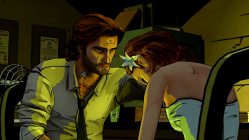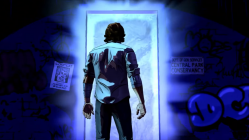When Telltale Games developed “The Wolf Among Us,” it forced players to consider the age old question: “Who’s afraid of the big bad wolf?” By centering the story around Bigby Wolf, sheriff of a modern fairy tale town, the question took a more literal context. Every choice made in the game has consequences and impacts the characters in various ways, meaning that every character very well could be afraid of the big bad wolf by the end of the game.
The story itself is a relatively popular one: fairy tale characters are forced to enter into the modern world — a fictional borough of New York called Fabletown — and assimilate. The end result is staunchly realistic and harshly gritty, revealing the limited capabilities that each character has and the reluctance many of them feel toward abandoning their titles of royalty. Their lives are far from perfect, but things go from bad to worse when a member of the community is murdered. It is up to Bigby to find out who the murderer is before they strike again.
The entire game is based around making decisions. Choices about places to investigate, questions to ask, accusations to make and fights to engage in will all change the course of the story. Though some consequences to decisions are felt more strongly than others, the game takes the opportunity to enforce the concept that even the tiniest choices can leave an impact. Decisions made in the beginning of the game can be brought up again at any point, while other decisions have an immediate effect.
This game finds its strength in its atmosphere. The graphics are rendered in a style reminiscent of comic book drawings – a Telltale signature – and the grimy setting of a rundown New York borough adds a depth of grittiness to this enchanted story that cannot be understated. The story itself has an undeniable resemblance to hardboiled fiction, with its crime narrative and cynical detective on the case. It follows the trope to a T, with only the occasional internal monologue missing.
Much of the game is spent pawing through evidence, and there can be moments when the setting can feel claustrophobic. There are specific objects that can be interacted with, specific characters that can be spoken to and specific pathways that can be tread upon. This fact alone makes the game tedious, with one of the biggest saving graces being the variety in choices that can be made. Unlike many choice-based games, “The Wolf Among Us” offers multiple options, multiple endings and multiple character interpretations.
Being episodic in nature, the game is told in five chapters, each one upping the ante of the last. The game does its best to ensure that the player is on the right path to solving the mystery, though many of the clues must be pieced together without assistance. Certain dialogue options can mislead the player, with options appearing to be much less violent than they turn out to be. That may be the games biggest strength: the choices are not as obvious as they might be in other choice-based games. There is no right or wrong decision, and the player would be justified in whatever choice they made. In the end, all or none of the characters may be afraid of the big bad wolf, and ultimately that makes this game worth playing.

